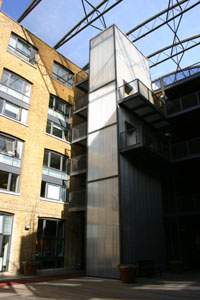Islington Council actively seeks to establish inclusive environments, which derive from an understanding of the needs and aspirations of our diverse communities and adapt to meet their different and evolving demands.
derive from an understanding of the needs and aspirations of our diverse communities and adapt to meet their different and evolving demands.
The council operates the London Plan policy 7.2:
An inclusive environment requires that developments:
- can be used safely, easily and with dignity by all regardless of disability, age, gender, ethnicity or economic circumstances;
- are convenient and welcoming with no disabling barriers, so everyone can use them independently without undue effort, separation or special treatment;
- are flexible and responsive taking account of what different people say they need and want, so people can use them in different ways;
- are realistic, offering more than one solution to help balance everyone’s needs, recognising that one solution may not work for all.
Islington’s core strategy echoes the London Plan policy:
Policy CS9 - Protecting and enhancing Islington’s built and historic environment: High quality architecture and urban design are key to enhancing and protecting Islington’s built environment, making it safer and more inclusive.
Islington’s emerging Development Management Policies DPD states:
Policy DM 2 - Inclusive Design
A. All developments shall demonstrate that they:
-
provide for ease of and versatility in use;
-
deliver safe, legible and logical environments;
-
produce places and spaces that are convenient and enjoyable to use for everyone, and
-
bring together the design and management of a development from the outset and over its lifetime.
What is Inclusive Design?
Inclusive Design is an approach to design that, by placing people at the heart of the design process, enhances the quality of our spaces and places, ensures their continuing relevance and minimises the need for awkward, costly and unsightly alteration in the future.
Ease of use and versatility are important features of an Inclusive Design. “Ease of use" means that access to, and enjoyment of, an environment should require minimal strength stress and effort and should be achievable in comfort; independently and/or with assistance delivered on the users’ terms. "Versatility" suggests a lack of prescription in a design and as a result, flexibility in use. Versatile solutions take into account diverse and evolving needs, whilst minimising the need for structural adaptation - an essential aspect of sustainability.
Logic, safety and legibility are essential aspects of an Inclusive Design because logical layouts and clear sightlines enable spaces and places to be understood without recourse to excessive text based signage. They inspire a sense of security and promote confidence, minimising the need for active surveillance and/or personal support.
Places and spaces that are convenient and enjoyable for all to use, must be designed with diversity in mind; addressing the specific and potentially conflicting physical, sensory, cognitive and social needs of people protected by current equalities legislation. This will ensure that barriers are designed out and flexibility built in. The provision of accessible, essential and appropriate services to support a development will also provide for and will enhance independence and contribute to the cohesion and sustainability of the community.
potentially conflicting physical, sensory, cognitive and social needs of people protected by current equalities legislation. This will ensure that barriers are designed out and flexibility built in. The provision of accessible, essential and appropriate services to support a development will also provide for and will enhance independence and contribute to the cohesion and sustainability of the community.
The success of an Inclusive Design will often be affected as much by its management as by its physical form. Shortcomings in the latter frequently place unreasonable and unsustainable demands on the former, and vice versa. Implications for the management of spaces and places, particularly when considering diverse and changing needs, should be considered and resolved at the earliest design stages.
How does Inclusive Design differ from accessible design?
Inclusive Design takes into account the diversity of complexity of our communities and is informed by the introduction of the Equalities Act 2010 which supersedes the Disability Discrimination Act and refers to nine protected characteristics:
-
age;

-
disability (including mobility, visual and hearing impaired people and people with learning difficulties and or mental health problems);
-
gender reassignment;
-
marriage and civil partnership;
-
pregnancy and maternity;
-
race;
-
religion or belief;
-
sex, and
-
sexual orientation.
Like the DDA, however, the Act requires that employers and service providers do not treat people, with any one or more of these characteristics, any less favourably than they would treat someone else. They are also required to make changes to policies, practices, procedures and premises to ensure that equality of treatment.
The Equalities Act also introduced a Public Sector Equality Duty. All public authorities now have a responsibility to:
-
eliminate relevant discrimination, harassment, victimisation;
-
advance equality of opportunity by removing or minimising disadvantage suffered by, and taking steps to reach, engage and meet the needs of, relevant groups, and
-
foster good relations between people protected by the current equalities legislation and the wider community by tackling prejudice and promoting understanding.
Further advice
The council's Inclusive Design officers are available to provide advice on legislation, policies and good practice. Please direct any queries to: InclusiveDesign@islington.gov.uk
